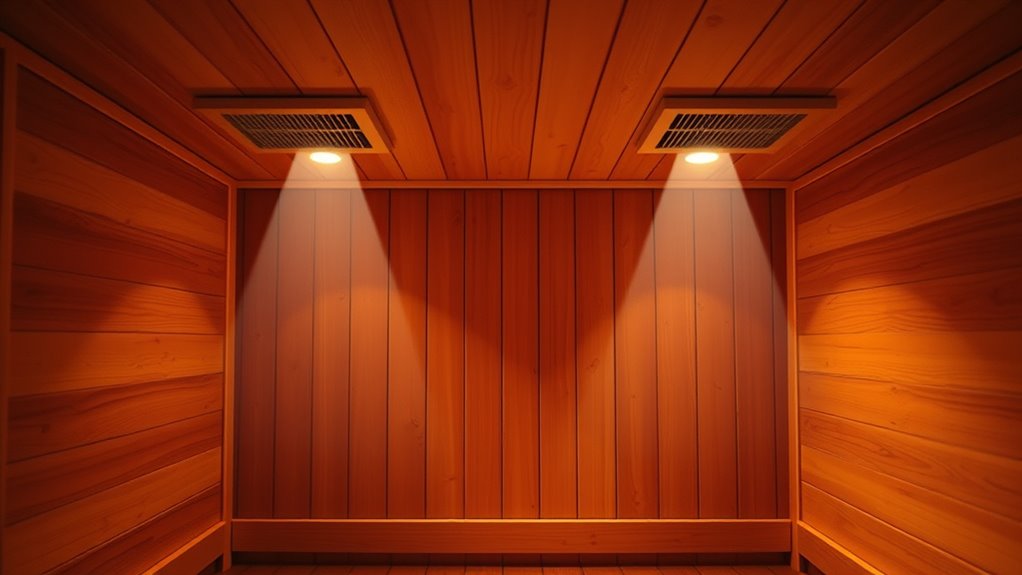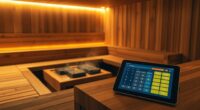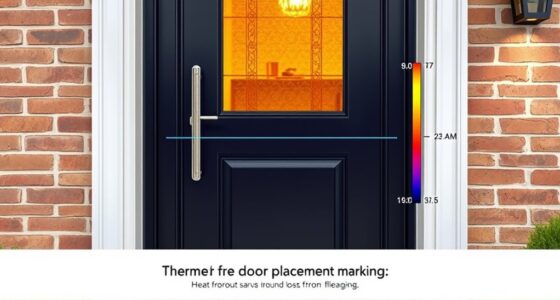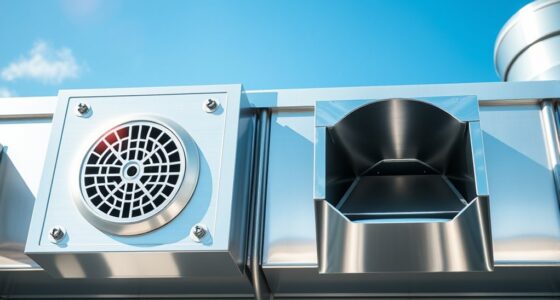To avoid common ventilation mistakes in small sauna rooms, ensure proper placement of intake vents near the floor and exhaust vents near the ceiling for ideal airflow. Choose the correct vent sizes, avoid obstructions, and plan for cross ventilation. Don’t overlook humidity control, material effects, or regular maintenance. Properly installing and managing vents during construction prevents moisture buildup and improves efficiency. Keep these tips in mind to create a balanced, safe environment—if you want to learn more, stay tuned.
Key Takeaways
- Properly position vents near the floor and ceiling to promote effective airflow and prevent stale air buildup.
- Ensure vent sizes match room volume to avoid restrictions, drafts, or uneven heat distribution.
- Avoid placing vents directly opposite each other to prevent airflow conflicts and poor circulation.
- Regularly inspect and maintain vent placement and sealing to prevent obstructions and moisture issues.
- Use sensors and adjustable vents to optimize airflow based on room usage and humidity levels.
Inadequate Air Intake Placement
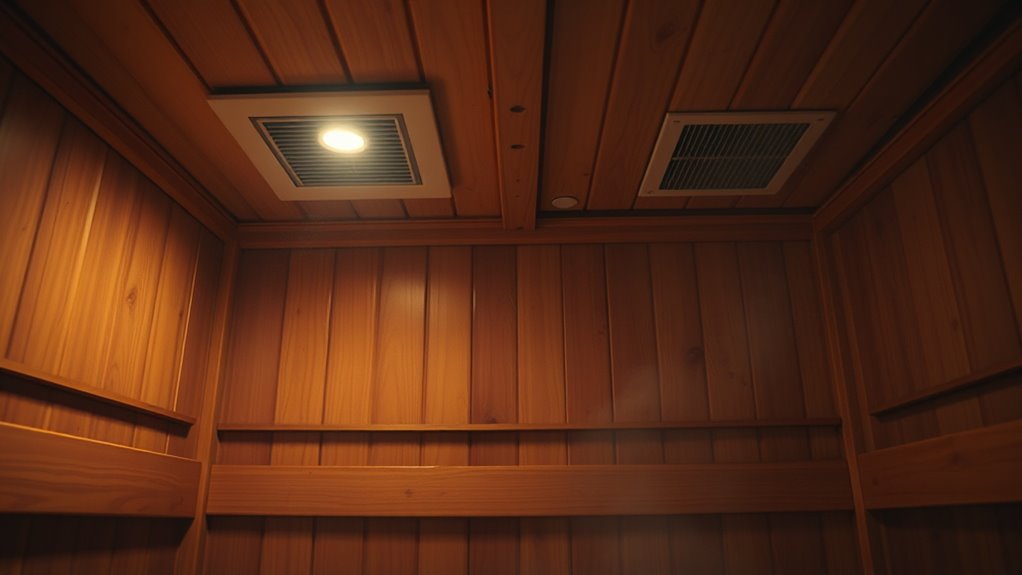
If the air intake is poorly positioned, it can considerably compromise ventilation in your small sauna room. The air intake location directly affects how fresh air circulates, so positioning it correctly is vital. Place the intake near the floor and opposite the heater to guarantee proper airflow. Using effective vent placement strategies, you can promote continuous air exchange without creating drafts or cold spots. Avoid installing vents too high or too close to the heater, as this can lead to stagnation or uneven heat distribution. Proper vent placement encourages fresh air to flow in smoothly while stale air exits efficiently. Remember, a well-placed air intake helps maintain a healthy, comfortable environment, preventing humidity buildup and ensuring your sauna stays inviting. Automation technologies can be utilized to monitor and optimize ventilation systems, ensuring consistent airflow and improving overall sauna conditions.
Poor Exhaust Vent Location

If your exhaust vent isn’t placed carefully, it can be hard to achieve proper airflow. Poor placement leads to challenges in vent positioning and can cause airflow obstructions. These issues reduce ventilation efficiency and can make your sauna uncomfortable. Ensuring the vent is correctly ventilation in small sauna rooms can help maintain optimal airflow and comfort.
Vent Placement Challenges
Poorly located exhaust vents can substantially hinder proper airflow in small sauna rooms, making ventilation difficult and less effective. When vents are poorly placed, air purification becomes compromised, leading to stale air and lingering odors. Additionally, scent dispersion suffers, reducing the relaxing experience. To optimize vent placement, consider these key factors:
- Position exhaust vents near the ceiling to facilitate hot, humid air removal.
- Avoid placing vents directly opposite the intake to promote even airflow.
- Ensure vents are unobstructed to allow effective air circulation and scent dispersal.
- Place vents away from seating areas to prevent drafts that can disturb relaxation.
- Understanding AI-driven insights can help identify the most effective vent locations based on airflow dynamics.
Proper placement enhances ventilation, improves air quality, and supports effective scent dispersion, creating a healthier sauna environment.
Airflow Obstruction Risks
When exhaust vents are poorly located, airflow in your sauna can become easily obstructed, leading to stagnant air and reduced ventilation efficiency. Incorrect vent placement disrupts air circulation patterns, causing uneven heat and moisture removal. To prevent this, consider ideal air filter placement and vent positioning. Poor airflow can also cause debris buildup or mold growth, reducing air quality. Incorporating proper ventilation techniques can further optimize airflow and maintain a healthier sauna environment.
Overlooking Cross Ventilation

Many small sauna rooms overlook the importance of cross ventilation, yet it plays an essential role in maintaining air quality and comfort. Without proper airflow circulation facilitated by strategic vent placement, stale air can accumulate, reducing the sauna’s effectiveness. To optimize cross ventilation, consider these points:
- Position vents across from each other to promote natural airflow.
- Ensure vents are unobstructed for maximum airflow circulation.
- Use adjustable vents to control airflow based on occupancy and temperature.
- Regularly inspect vent placement to prevent blockage and ensure efficient air exchange.
- Incorporating sound healing science principles can help create a more relaxing environment by promoting balanced air vibrations and overall well-being.
Using Incorrect Vent Sizes

Using the correct vent sizes is essential for effective ventilation in small sauna rooms. If the vents are too small, airflow becomes restricted, leading to poor air exchange and stuffiness. Conversely, oversized vents can cause drafts and compromise temperature control. Proper vent sizing ensures balanced airflow, improving ventilation aesthetics and comfort. It also allows you to choose decorative vent covers that blend seamlessly with your sauna’s design, enhancing its overall look. Incorrect vent sizes can result in inefficient ventilation, affecting both safety and enjoyment. Always measure carefully and follow manufacturer guidelines when selecting vent dimensions. Proper vent sizing is critical for maintaining optimal humidity levels and preventing mold growth. By getting the sizes right, you maintain ideal airflow, prevent overheating, and create a visually appealing space that’s both functional and stylish.
Neglecting Humidity Control
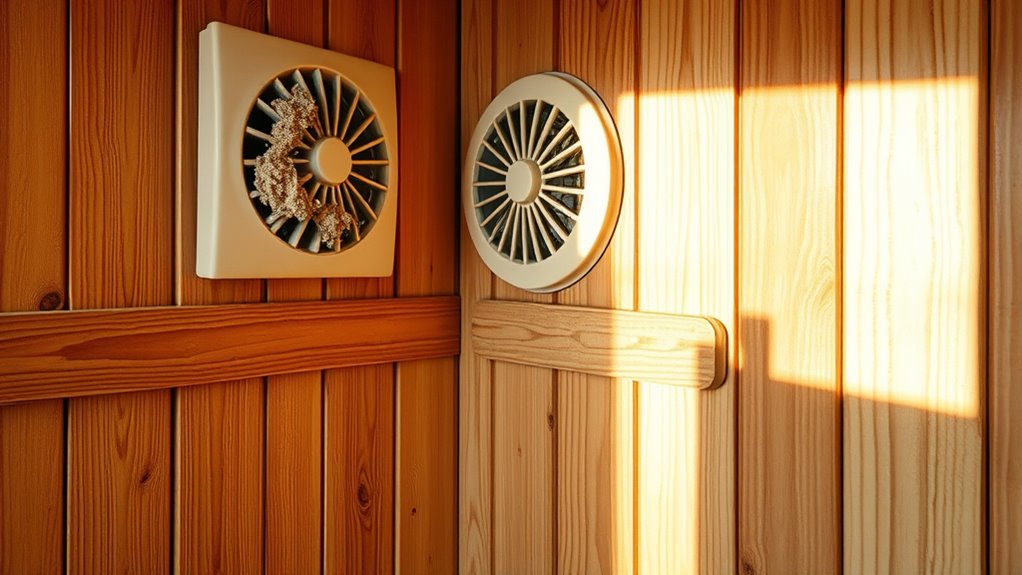
Have you overlooked humidity control in your small sauna room? Ignoring humidity management can lead to discomfort and damage. To avoid this, consider these key points:
- Install reliable humidity sensors to monitor moisture levels accurately.
- Integrate a dehumidifier to maintain ideal humidity, preventing excess moisture buildup.
- Regularly check sensor calibration for consistent readings.
- Adjust dehumidifier settings based on sensor data to keep humidity within suitable ranges.
- Using expert voice actors or specialized soundscapes in your setup can help create a calming atmosphere that complements humidity control efforts.
Neglecting humidity control can cause mold, wood deterioration, and an uncomfortable environment. Proper sensor placement and dehumidifier integration ensure your sauna remains safe, comfortable, and well-maintained. Don’t underestimate the importance of moisture management; it’s essential for a pleasant sauna experience.
Improper Ventilation for Heater Operation

Proper ventilation is essential for safe and efficient heater operation in your small sauna room. Insufficient airflow can lead to poor air quality and excessive moisture buildup, risking equipment damage and health issues. To ensure proper heater function, maintain balanced ventilation that allows fresh air in and stale air out. Use this table to guide your setup:
| Ventilation Type | Purpose | Effect on Air Quality & Moisture |
|---|---|---|
| Intake vents | Bring in fresh air | Improves air quality, reduces moisture buildup |
| Exhaust vents | Remove damp, stale air | Prevents excess humidity, enhances comfort |
| Cross ventilation | Promote airflow | Maintains consistent air quality, moisture control |
| Ventilation fans | Aid in airflow | Ensures continuous air exchange |
Properly managing ventilation helps your heater operate efficiently, controls moisture, and maintains a healthy sauna environment. Effective ventilation strategies are key to preventing mold and maintaining a comfortable temperature.
Failing to Account for Room Size and Usage

You need to take into account the size of your sauna room because it directly affects how much ventilation is required. If you underestimate usage frequency, the ventilation might not keep the air fresh enough during busy times. Finding the right balance ensures proper airflow without over-ventilating or under-ventilating your space. Additionally, understanding the IRA investment strategy can help you plan financially for upgrades or adjustments needed for optimal ventilation solutions.
Room Dimensions Impact
Ignoring the size and intended use of a small sauna room can lead to inadequate ventilation and uncomfortable conditions. If you don’t consider room dimensions, you risk poor airflow, increased ventilation noise, and compromised aesthetic considerations. Larger rooms require more airflow, so installing too few vents can cause stagnation and discomfort. Conversely, overly large vents in small spaces create noise issues and disrupt the sauna’s ambiance. To optimize ventilation, keep these factors in mind: 1. Match vent size to room volume for balanced airflow 2. Position vents to minimize ventilation noise and maintain serenity 3. Consider aesthetic integration of vents to preserve design integrity 4. Adjust ventilation based on usage intensity and room dimensions. Additionally, understanding the importance of proper vent placement helps ensure effective airflow and overall comfort. Proper planning ensures comfort, quietness, and visual harmony.
Usage Frequency Effects
When a sauna’s usage frequency increases without adjusting the ventilation accordingly, it can lead to discomfort and potential safety issues. Higher usage means more moisture and heat buildup, which can cause excessive ventilation noise if your system isn’t scaled properly. This noise can become distracting and diminish the relaxing atmosphere you want. Additionally, neglecting to contemplate how often the sauna is used can impact aesthetic considerations; loud or improperly integrated ventilation units may detract from the room’s visual appeal. Regularly updating your ventilation setup to match usage frequency ensures efficient airflow, reduces noise, and maintains a clean, inviting look. Failing to do so risks poor air quality, increased wear on equipment, and an overall less enjoyable sauna experience.
Ventilation Balance Needs
Properly balancing your sauna’s ventilation depends heavily on both the room’s size and how often it’s used. If you neglect these factors, you risk poor air quality and ineffective temperature regulation. To ensure proper ventilation balance, consider these key needs:
- Adjust airflow rates based on room volume to maintain fresh air without overcooling.
- Increase ventilation if the sauna is used frequently to prevent buildup of humidity and odors.
- Use sensors or timers to monitor air quality and optimize airflow accordingly.
- Recognize that larger rooms require more substantial ventilation to regulate temperature effectively and keep air fresh.
Failing to account for these elements can lead to uncomfortable conditions and compromised safety. Proper balance ensures a pleasant, healthy sauna experience.
Blocking Vent Openings With Furniture or Accessories
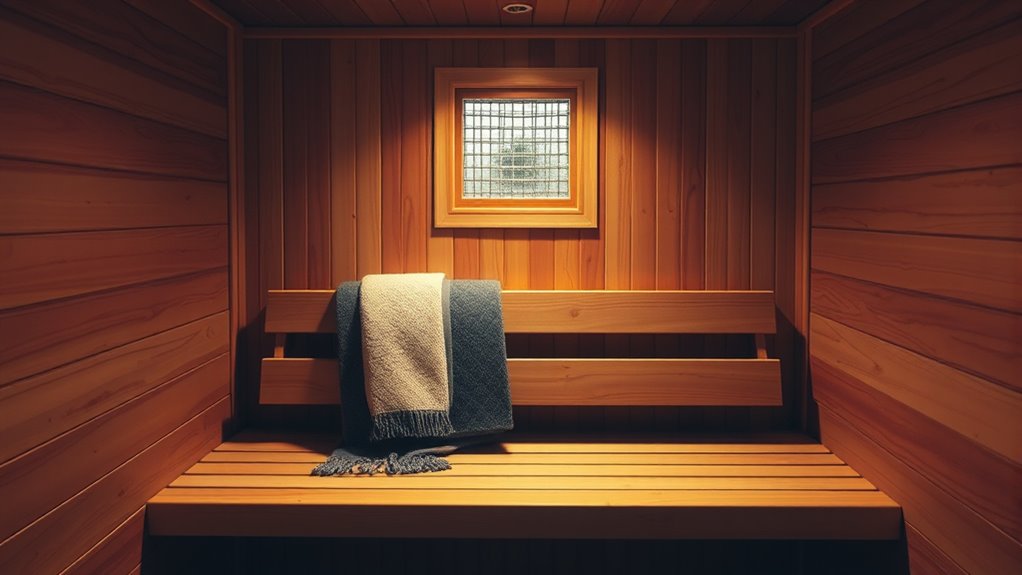
Blocking vent openings with furniture or accessories can markedly disrupt proper airflow in small sauna rooms. When you cover vents with decorative vent covers or place furniture nearby, you hinder the natural circulation of fresh air. This can lead to uneven heat distribution and stale air buildup, affecting your sauna experience. Additionally, obstructed vents often cause increased ventilation noise levels as the air struggles to pass through restricted openings. If you choose decorative vent covers, ensure they don’t block airflow entirely. Keep furniture and accessories away from vent openings to maintain proper ventilation efficiency. Proper airflow is essential for safety, comfort, and ideal sauna performance. Avoid these common mistakes to enjoy a well-ventilated, pleasant sauna environment.
Not Considering Airflow Direction
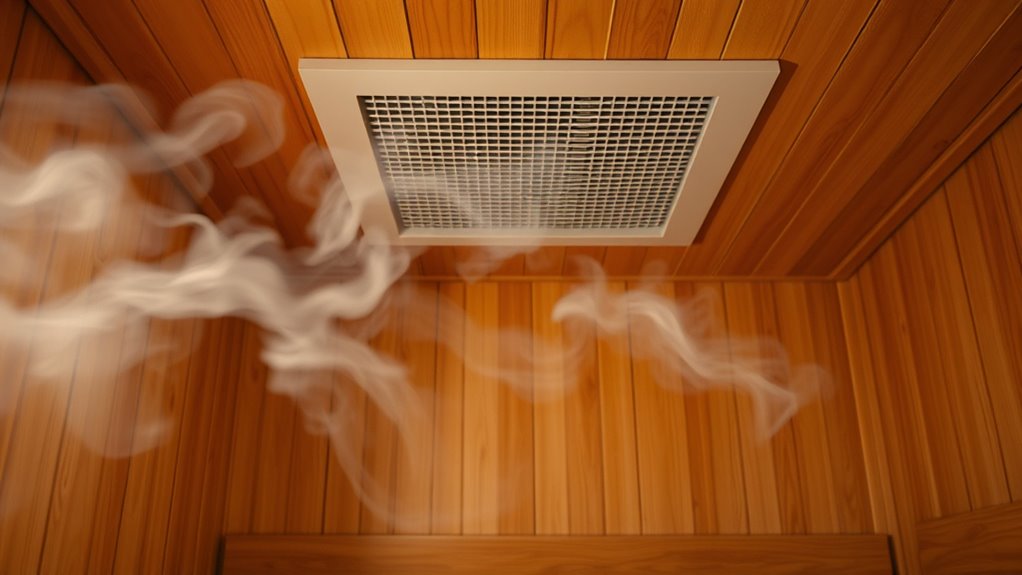
Have you considered how the direction of airflow impacts your sauna’s ventilation? Proper airflow direction guarantees efficient ventilation flow, preventing stale air buildup and controlling humidity. If you ignore this, you risk uneven temperature distribution and poor air quality. To optimize ventilation, focus on:
- Positioning vents to promote a natural airflow path from intake to exhaust.
- Ensuring air enters near the heater for effective heat distribution.
- Avoiding placement that causes airflow to circulate in circles or stagnate.
- Adjusting vent angles to direct airflow where it’s most needed.
Understanding airflow direction helps you create a balanced ventilation flow, reducing condensation and improving comfort. Neglecting this aspect can lead to inefficient ventilation and compromise your sauna experience.
Ignoring Material and Insulation Effects on Ventilation
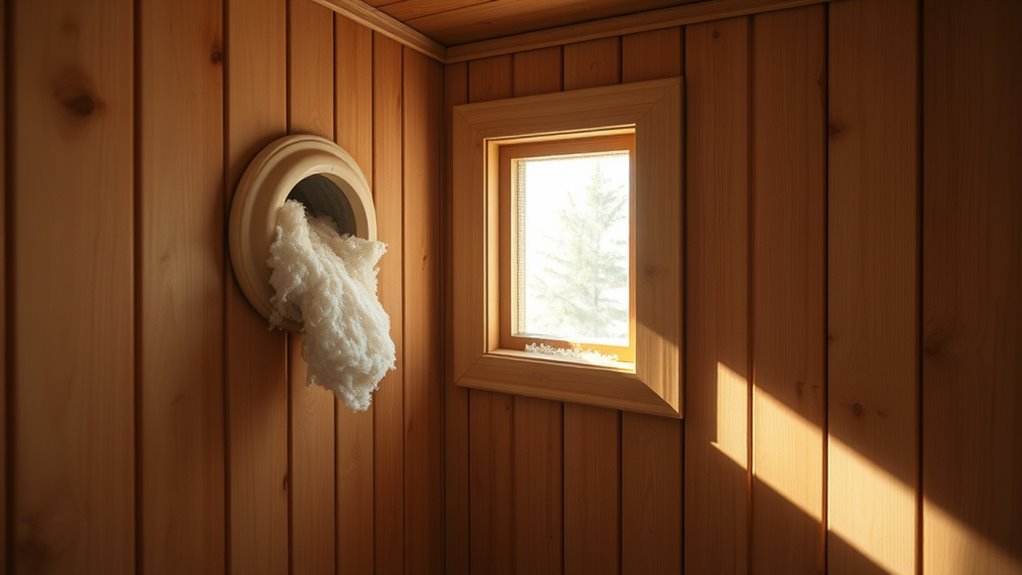
Since the materials you choose for your sauna walls and insulation considerably influence ventilation, overlooking their effects can cause serious issues. Material effects determine how well heat and moisture transfer, which directly impacts air circulation. Some materials, like dense wood or concrete, can trap heat and moisture, reducing airflow and causing humidity build-up. Insulation impact also plays a role; poor or improper insulation can lead to uneven temperature distribution, encouraging stagnant air pockets. If you disregard these factors, ventilation systems may struggle to keep the space dry and comfortable. Choosing the right materials and understanding their effects ensures proper airflow, prevents moisture issues, and maintains a healthy sauna environment. Don’t underestimate how material effects and insulation impact your sauna’s ventilation performance.
Insufficient Vent Maintenance and Cleaning
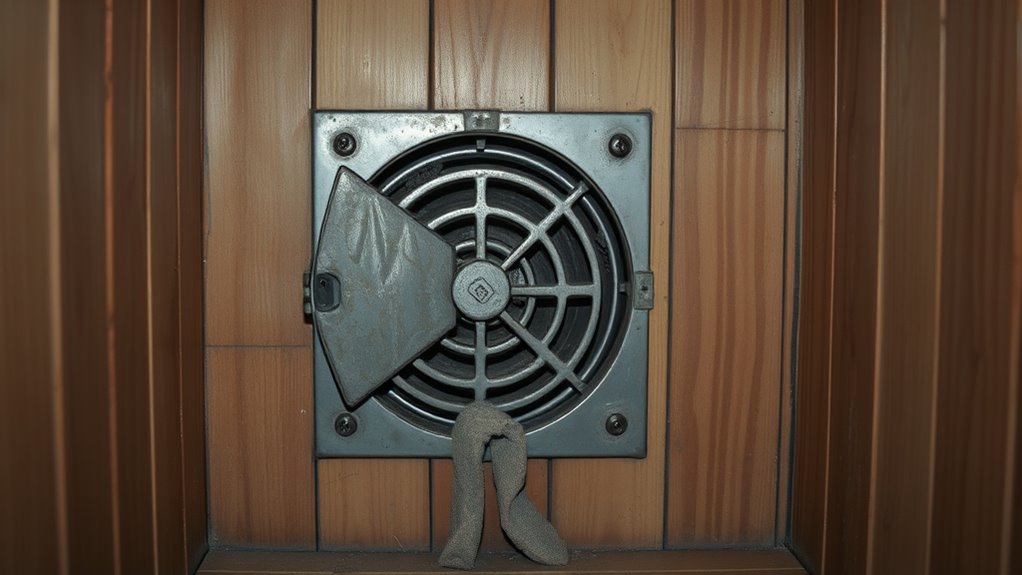
Regularly maintaining and cleaning your sauna vents is essential to guarantee proper airflow and prevent issues like musty odors or moisture buildup. Neglecting this can lead to poor ventilation, mold growth, and equipment damage. To keep your system in top shape, consider these steps:
Regular sauna vent maintenance ensures optimal airflow and prevents mold and odors.
- Establish a regular vent cleaning schedule to remove dust and debris.
- Inspect vents for blockages and ensure unobstructed airflow.
- Upgrade your ventilation system when necessary to improve efficiency.
- Schedule professional vent assessments to identify potential issues early.
Lack of Proper Ventilation Planning During Construction

If you skip proper ventilation system design during construction, your sauna may not vent effectively. Poor oversight can lead to inaccuracies in installation, causing airflow issues. Addressing these points early guarantees your sauna stays comfortable and well-ventilated.
Ventilation System Design
Poor planning of the ventilation system during construction can lead to significant issues in small sauna rooms. Without proper design, you risk poor air quality and inadequate thermal regulation, making the space uncomfortable and unsafe. To avoid this, focus on these key points:
- Guarantee ventilation openings are strategically placed for ideal airflow.
- Size the ventilation system appropriately to handle the sauna’s volume.
- Incorporate adjustable vents to maintain consistent air exchange.
- Use high-quality materials that withstand heat and moisture.
Construction Oversight Accuracy
When ventilation systems aren’t carefully monitored during construction, small sauna rooms often suffer from overlooked design flaws. Poor construction oversight accuracy can lead to incorrect installation or placement of vents, which compromises ventilation system longevity. Without proper oversight, essential details like airflow paths and sealing quality may be neglected, resulting in inefficient ventilation. This can cause moisture buildup, mold growth, and reduce the lifespan of your system. Ensuring precise oversight during construction helps catch mistakes early, preventing costly repairs later. It’s vital to verify that all components are correctly installed according to plan, with attention to sealing and vent positioning. Accurate construction oversight is the key to a reliable, long-lasting ventilation system that maintains ideal air quality and safety in your sauna.
Frequently Asked Questions
How Does Ventilation Affect Sauna Safety and Comfort?
Proper ventilation directly impacts your sauna’s safety and comfort by ensuring ideal airflow efficiency and meeting ventilation standards. When ventilation is effective, it prevents overheating, reduces humidity, and maintains fresh air, making your experience safer and more enjoyable. Neglecting these aspects can cause discomfort, poor air quality, and potential health risks. So, always prioritize adequate ventilation to keep your sauna safe, comfortable, and within suitable ventilation standards.
Can Poor Ventilation Cause Mold or Moisture Problems?
Like a silent villain in your sauna, poor ventilation can indeed cause mold and moisture issues. Without proper humidity control and airflow optimization, excess moisture lingers, creating a perfect environment for mold growth. This not only damages your sauna but also affects your health. To prevent this, guarantee your ventilation system is effective, allowing fresh air in and moisture out, keeping your sauna safe, dry, and enjoyable.
What Are the Signs of Inadequate Sauna Ventilation?
You’ll notice signs of inadequate sauna ventilation when airflow patterns feel stagnant, causing stuffiness or excessive humidity. Poor ventilation efficiency often leads to lingering odors, mold growth, or moisture buildup on walls and benches. If you feel temperature inconsistencies or difficulty maintaining the desired heat levels, it’s a clear sign that airflow isn’t circulating properly. Addressing these issues guarantees your sauna remains comfortable, safe, and well-ventilated.
How Often Should Sauna Ventilation Systems Be Inspected?
Think of your sauna’s ventilation system as its heartbeat—regular checkups keep it healthy. You should inspect your ventilation system at least twice a year to guarantee proper airflow optimization. Regular ventilation maintenance prevents buildup of debris and ensures the system runs smoothly, helping you avoid stuffy, unbalanced air. Staying proactive with inspections keeps your sauna’s environment safe, comfortable, and inviting, so you can enjoy your sessions without worry.
Are There Specific Regulations for Sauna Ventilation Design?
Yes, there are specific regulations for sauna ventilation design to guarantee good sauna air quality and meet ventilation standards. You should follow local building codes and standards like ASHRAE or European norms, which specify airflow rates, vent placement, and humidity control. These regulations help prevent issues like mold, odors, and poor air quality, ensuring a safe and comfortable sauna experience. Always check your local rules before designing or upgrading your sauna ventilation system.
Conclusion
To keep your small sauna room safe and comfortable, avoid these common ventilation mistakes. Proper airflow minimizes humidity issues and prevents mold growth. Did you know that poor ventilation can increase energy costs by up to 30%? By paying attention to vent placement, maintenance, and humidity control, you ensure a healthier sauna experience. Don’t overlook these details—your sauna’s longevity and your comfort depend on it!
